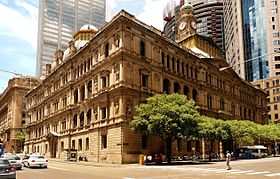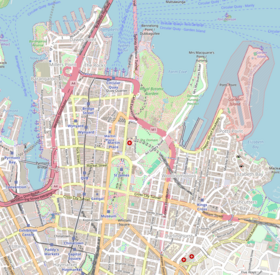| Department of Lands building | |
|---|---|
 Bridge Street façade of the Department of Lands building | |
Location in the Sydney central business district | |
| General information | |
| Type | Government administration |
| Architectural style | Victorian Renaissance Revival |
| Address | 22–33 Bridge Street, Sydney, New South Wales |
| Country | Australia |
| Coordinates | 33°51′50″S 151°12′36″E / 33.863915°S 151.209933°E |
| Current tenants | Pontiac Land Group |
| Construction started | 1876 |
| Estimated completion | 1892 |
| Owner | Government of New South Wales |
| Height | |
| Roof | Copper dome, 17 metres (55 ft) square to octagon |
| Dimensions | |
| Other dimensions | Clock tower with copper 'onion' top |
| Technical details | |
| Structural system | Reinforced concrete slabs |
| Material | Pyrmont sandstone |
| Floor count | 3 |
| Design and construction | |
| Architect(s) |
|
| Architecture firm | Colonial Architect of New South Wales |
| Developer | Government of New South Wales |
| Main contractor |
|
| Official name | Lands Department Building |
| Type | State heritage (built) |
| Designated | 2 April 1999 |
| Reference no. | 744 |
| Type | Administration Office |
| Category | Government and Administration |
| References | |
| [1] | |
The Department of Lands building is a heritage-listed[2] state government administrative building of the Victorian Renaissance Revival architectural style located in Bridge Street in the Sydney central business district of New South Wales, Australia. The large three-storey public building was designed by Colonial Architect James Barnet and built in different stages, with Walter Liberty Vernon and William Edmund Kemp designing various components of the building. The builder was John Young.[1]
The building was initially occupied by the NSW Department of Lands, which has a long association with the public life of New South Wales, especially the rapid expansion of settlement during the later part of the 19th century. It was added to the New South Wales State Heritage Register on 2 April 1999. In the late 1980s, the building was earmarked by the NSW Government as one of the possible sites for conversion into a casino. A permanent conservation order covering the premises was passed by the Heritage Council of New South Wales in order to protect the building from unsympathetic development.[1] The NSW Department of Planning moved out in 2016 and as of 2024 the building was being redeveloped by Singapore developer Pontiac Land Group, together with the nearby Department of Education building, to become a luxury hotel, currently marketed as "the sandstone precinct".[3][4]
- ^ a b c "Lands Department Building". New South Wales State Heritage Register. Department of Planning & Environment. H00744. Retrieved 13 October 2018.
 Text is licensed by State of New South Wales (Department of Planning and Environment) under CC BY 4.0 licence.
Text is licensed by State of New South Wales (Department of Planning and Environment) under CC BY 4.0 licence.
- ^ Australian Heritage Commission (1981), The Heritage of Australia: the illustrated register of the National Estate, South Melbourne: The Macmillan Company of Australia in association with the Australian Heritage Commission, p. 94, ISBN 978-0-333-33750-9
- ^ Davies, Anne (21 April 2018). "Fears over fate of historic Sydney sandstone building". Guardian Australia. Retrieved 16 November 2019.
- ^ Cormack, Lucy; Fisher, Jack (11 November 2016). "The Sandstones to become world class hotel, complete with rooftop salon". The Sydney Morning Herald. Retrieved 16 November 2019.
